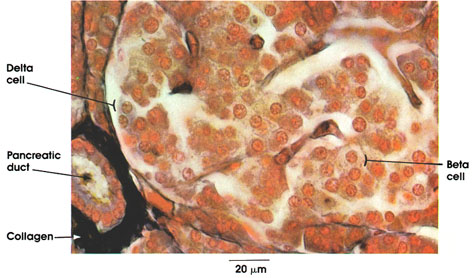

Plate 15.291 Pancreas
Ronald A. Bergman, Ph.D., Adel K. Afifi, M.D., Paul M. Heidger,
Jr., Ph.D.
Peer Review Status: Externally Peer Reviewed

Human, Helly's fluid, Mallory-azan stain, 612 x.
The islets of Langerhans were described by Paul Langerhans, a German physician, anatomist, and pathologist, in 1869. Although in routine histological preparations all of the islet cells appear to be similar, special methods reveal three types, alpha, beta, and delta.
Delta cell: Few in number compared to alpha or beta cells. Significance not well understood. Cytoplasm stains blue with Mallory-azan.
Beta cell: More numerous than alpha or delta cells. Produce insulin. Insulin increases cellular uptake of glucose and its conversion to glycogen. Beta cells may occur outside the islets. Granules are diffusely scattered in cytoplasm.
Pancreatic duct: Found interlobular connective tissue, lined by cuboidal to columnar epithelium. Size varies Collagen: In the interlobular connective tissue. Stains dark blue with Mallory-azan.
Alpha cells (not seen in this preparation) secrete the hormone glucagon, which effects the breakdown of liver glycogen and elevates the blood glucose level.
Next Page | Previous Page | Section Top | Title Page
Please send us comments by filling out our Comment Form.
All contents copyright © 1995-2025 the Author(s) and Michael P. D'Alessandro, M.D. All rights reserved.
"Anatomy Atlases", the Anatomy Atlases logo, and "A digital library of anatomy information" are all Trademarks of Michael P. D'Alessandro, M.D.
Anatomy Atlases is funded in whole by Michael P. D'Alessandro, M.D. Advertising is not accepted.
Your personal information remains confidential and is not sold, leased, or given to any third party be they reliable or not.
The information contained in Anatomy Atlases is not a substitute for the medical care and advice of your physician. There may be variations in treatment that your physician may recommend based on individual facts and circumstances.
URL: http://www.anatomyatlases.org/